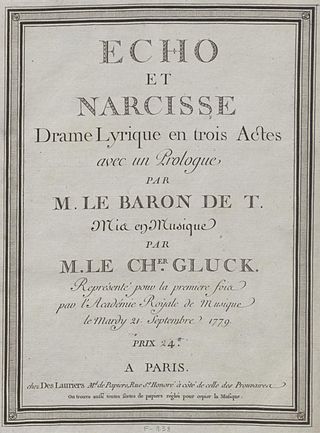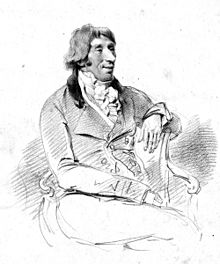
Écho et Narcisse is a 1779 drame lyrique in three acts, the last original opera written by Christoph Willibald Gluck, his sixth for the French stage. The libretto, written by Louis-Théodore de Tschudi, tells the story of the love between Echo and Narcissus.

Le tableau parlant is an opéra comique, described as a comédie-parade, in one act by André Grétry, The French libretto was by Louis Anseaume.

Fra i due litiganti il terzo gode is a dramma giocoso in two acts by Giuseppe Sarti. The libretto was after Carlo Goldoni's Le nozze.

Medonte, re di Epiro is an opera seria in three acts by Giuseppe Sarti. The libretto was by Giovanni de Gamerra for Felice Alessandri's opera Medonte, re d'Epiro (1774) and was later set by several other composers.

Calliroe is an opera by Antonio Sacchini, set to a libretto by Mattia Verazi. It was first performed in Schloss Ludwigsburg on 11 February 1770 and the ballets were set by French choreographer Louis Dauvigny.

La mère coupable is an opera in three acts, Op. 412, by Darius Milhaud to a libretto by Madeleine Milhaud after the 1792 play, the third in Beaumarchais’ Figaro trilogy. It premiered at the Grand Théâtre de Genève on 13 June 1966.

Sigismondo is an operatic 'dramma' in two acts by Gioachino Rossini to an Italian libretto by Giuseppe Maria Foppa.
La pastorella nobile is an commedia per musica in two acts by Pietro Alessandro Guglielmi. The Italian libretto was by Francesco Saverio Zini.

Semiramide riconosciuta is an Italian opera with serious action, or dramma per musica, by Nicola Porpora, set to a libretto by Metastasio with some textual changes, possibly by Domenico Lalli. The opera was written for some of the finest contemporary singers, and includes a technically demanding series of da capo arias.

Conchita is an opera in four acts and six scenes by composer Riccardo Zandonai. The work uses an Italian language libretto by Maurizio Vaucaire and Carlo Zangarini which is based on Pierre Louÿs's 1898 novel La Femme et le pantin. The work premièred in Milan at the Teatro dal Verme on 14 October 1911 with soprano Tarquinia Tarquini, who later married Zandonai in 1917, in the title role. Her portrayal was lauded by critics and she went on to perform Conchita at the Royal Opera, London (1912), the Cort Theatre in San Francisco (1912), the Philharmonic Auditorium in Hollywood (1912), the Heilig Theatre in Portland (1912), the Metropolitan Opera House in Philadelphia (1912), the Chicago Grand Opera Company (1913), and the Teatro di San Carlo in Naples (1913). The opera was published by G. Ricordi & Co in 1912.

Calto is an opera seria in three acts by Francesco Bianchi. The libretto was by Giuseppe Maria Foppa, after the 'Celtic' poetry of Ossian. The opera was first performed at the Teatro San Benedetto in Venice on 23 January 1788.

Zemira is an opera seria in three acts by Francesco Bianchi. The libretto was by Gaetano Sertor.

Arbace is an opera seria in three acts by Francesco Bianchi. The libretto was by Gaetano Sertor.

Seleuco, re di Siria is an opera seria in three acts by Francesco Bianchi. The libretto was by Mattia Botturini, after Antioco by Apostolo Zeno and Pietro Pariati, a libretto first set by Francesco Gasparini in 1705.

La morte di Cesare is an opera seria in three acts by Francesco Bianchi. The libretto was by Gaetano Sertor, after Shakespeare's play Julius Caesar.

Alonso e Cora is an opera seria in three acts by Francesco Bianchi. The libretto was by Giuseppe Foppa, after Ferdinando Moretti's Idalide, o sia La vergine del sole, as used by Giuseppe Sarti in Milan in 1783. The original source of this text was in turn Jean François Marmontel's Les Incas, ou La destruction de l'empire du Pérou (1777).
Mattia Verazi was an Italian librettist primarily active at the court of Charles Theodore in Mannheim. He became known as the leader of a group of librettists who challenged the conventions of opera seria in the mid-18th century and was a long-time collaborator of composer Niccolò Jommelli. He also produced the libretti for Salieri's Europa riconosciuta, Sacchini's Calliroe, and J. C. Bach's Temistocle









